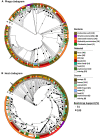UPΦ phages, a new group of filamentous phages found in several members of Enterobacteriales
- PMID: 32607251
- PMCID: PMC7307601
- DOI: 10.1093/ve/veaa030
UPΦ phages, a new group of filamentous phages found in several members of Enterobacteriales
Abstract
Filamentous phages establish chronic infections in their bacterial hosts, and new phages are secreted by infected bacteria for multiple generations, typically without causing host death. Often, these viruses integrate in their host's genome by co-opting the host's XerCD recombinase system. In several cases, these viruses also encode genes that increase bacterial virulence in plants and animals. Here, we describe a new filamentous phage, UPϕ901, which we originally found integrated in a clinical isolate of Escherichia coli from urine. UPϕ901 and closely related phages can be found in published genomes of over 200 other bacteria, including strains of Citrobacter koseri, Salmonella enterica, Yersinia enterocolitica, and Klebsiella pneumoniae. Its closest relatives are consistently found in urine or in the blood and feces of patients with urinary tract infections. More distant relatives can be found in isolates from other environments, including sewage, water, soil, and contaminated food. Each of these phages, which we collectively call 'UPϕ viruses', also harbors two or more novel genes of unknown function.
Keywords: bacteriophage; bladder; inovirus; prophage.
© The Author(s) 2020. Published by Oxford University Press.
Figures




Similar articles
-
'Big things in small packages: the genetics of filamentous phage and effects on fitness of their host'.FEMS Microbiol Rev. 2015 Jul;39(4):465-87. doi: 10.1093/femsre/fuu007. Epub 2015 Feb 10. FEMS Microbiol Rev. 2015. PMID: 25670735 Review.
-
The fascinating biology behind phage display: filamentous phage assembly.Mol Microbiol. 2019 May;111(5):1132-1138. doi: 10.1111/mmi.14187. Epub 2019 Mar 26. Mol Microbiol. 2019. PMID: 30556628 Review.
-
Bacteriophages of the Urinary Microbiome.J Bacteriol. 2018 Mar 12;200(7):e00738-17. doi: 10.1128/JB.00738-17. Print 2018 Apr 1. J Bacteriol. 2018. PMID: 29378882 Free PMC article.
-
Emergence of a Competence-Reducing Filamentous Phage from the Genome of Acinetobacter baylyi ADP1.J Bacteriol. 2016 Nov 4;198(23):3209-3219. doi: 10.1128/JB.00424-16. Print 2016 Dec 1. J Bacteriol. 2016. PMID: 27645387 Free PMC article.
-
Filamentous phages of Ralstonia solanacearum: double-edged swords for pathogenic bacteria.Front Microbiol. 2013 Nov 4;4:325. doi: 10.3389/fmicb.2013.00325. eCollection 2013. Front Microbiol. 2013. PMID: 24204365 Free PMC article.
Cited by
-
Filamentous Bacteriophages and the Competitive Interaction between Pseudomonas aeruginosa Strains under Antibiotic Treatment: a Modeling Study.mSystems. 2021 Jun 29;6(3):e0019321. doi: 10.1128/mSystems.00193-21. Epub 2021 Jun 22. mSystems. 2021. PMID: 34156288 Free PMC article.
-
Interactions of Bacteriophages with Animal and Human Organisms-Safety Issues in the Light of Phage Therapy.Int J Mol Sci. 2021 Aug 19;22(16):8937. doi: 10.3390/ijms22168937. Int J Mol Sci. 2021. PMID: 34445641 Free PMC article. Review.
-
Rephine.r: a pipeline for correcting gene calls and clusters to improve phage pangenomes and phylogenies.PeerJ. 2021 Aug 6;9:e11950. doi: 10.7717/peerj.11950. eCollection 2021. PeerJ. 2021. PMID: 34434663 Free PMC article.
-
Acinetobacter baumannii and Klebsiella pneumoniae Isolates Obtained from Intensive Care Unit Patients in 2024: General Characterization, Prophages, Depolymerases and Esterases of Phage Origin.Viruses. 2025 Apr 26;17(5):623. doi: 10.3390/v17050623. Viruses. 2025. PMID: 40431639 Free PMC article.
-
Filamentous prophages in the genomes of Acinetobacter baumannii from egypt: impact on biofilm formation and the potential to induce enterotoxicity.BMC Microbiol. 2025 Jul 23;25(1):449. doi: 10.1186/s12866-025-04177-z. BMC Microbiol. 2025. PMID: 40702445 Free PMC article.
References
LinkOut - more resources
Full Text Sources
Miscellaneous

